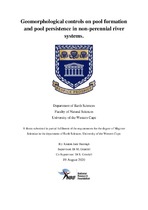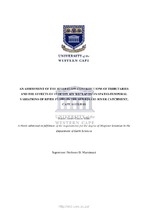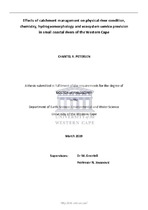| dc.description.abstract | Globally climate variability and anthropogenic effects are causing more perennial rivers to become non-perennial rivers. Non-perennial rivers are distinguished by their isolated pools which serve as refugia for aquatic organisms, water birds, and riparian vegetation. The literature on non-perennial rivers demonstrates that pools are poorly understood in terms of their location, nature, and geomorphic persistence. Therefore, this study examines the relationships between the spatial distribution, morphology, and substrate characteristics of pools in reaches of the Prins and Touws rivers in the Klein Karoo. A greater understanding of pools will facilitate better management, monitoring, and restoration strategies for pool ecology since the geomorphology of pools provides a key part of the ecological template.
Worldview-2 satellite imagery (2017) and orthorectified aerial photography (2014, 2013, and 1944) were used to assess the effects of major flooding events on pools over time. A DGPS (Differential Global Positioning System) was used to survey the pool widths, lengths, depths, and valley widths, cross-sections, and longitudinal profiles of the river. Sediment samples and Wolman pebble counts were used to assess the grain size and organic matter content of each pool in the study area. Detailed descriptions of the characteristics of each pool in terms of position in the channel, valley form, and obstruction presence and type were also assessed.
Results indicate that most of the large pools occur at bedrock outcrops of the valley margins, and smaller pools are associated with Vachellia karroo debris bar features. Larger and highly persistent pools are associated with valley confinement and smaller less persistent, scour pools occur mid-channel where the valley expands. Analysis of the results shows that the valley width is the dominant control on these forced pools. The type of obstruction also plays a role in the formation of the pool as large woody debris results in smaller pools whereas, bedrock outcrops result in larger sized pools. A significant relationship was found between the grain size and organic matter content of pools.
Aerial photography of the spatial distribution of the pools revealed that before a major flood, the pools were small and patchy, whereas afterward, they were larger and more elongated. It is suggested that at the bedrock outcrops, major scouring and eddy processes drive the formation of larger pools during large flood events, whereas pool dissection by sediment deposits prevails during intervening intermediate to low flow periods. The results are discussed in terms of the geomorphic controls (valley width, pool dimensions, morphology, substrate, and obstruction characteristics) on the formation and maintenance of pools in dryland settings. A conceptual
model is proposed to explain the geomorphic changes of the pools in the four geomorphological zones of non-perennial rivers. | en_US |




